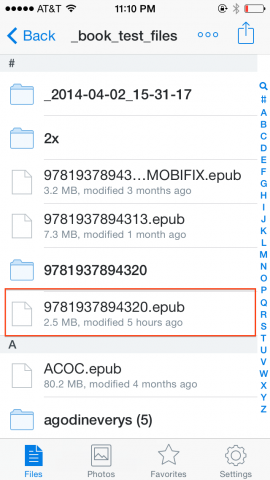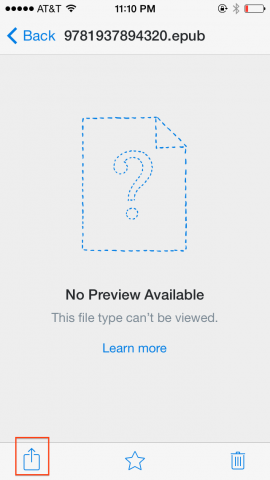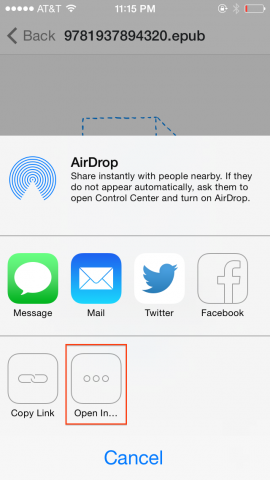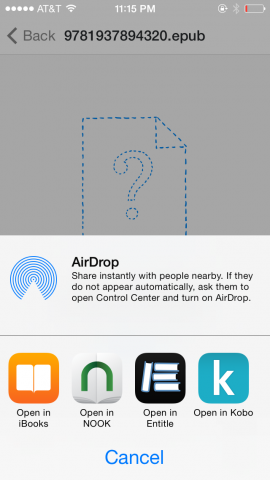File Testing with Dropbox, Part 1: iOS
One of my favorite tricks to testing files across a lot of devices is using Dropbox, a common app that syncs files across multiple devices and computers. Today starts a little series on using Dropbox to make file testing less painful.
Can we all agree that one of the biggest pains in EPUB creation is testing across multiple devices and apps? Not only are there ~5or 6 major e-ink readers you need to keep an eye on, but with the explosion in iOS and Android devices there’s also tablets, phones, and all the e-reader apps for each one.
Here’s a quick way to make file checking a bit easier with Dropbox. It won’t solve the need for e-ink file side-loading, but it will make your tablet and app testing a lot easier.
Dropbox
If you’ve never used Dropbox, its a great application that allows you to sync files to multiple devices and computers. If you have files you want to share at home with your computer at work, you just drag them into a folder and they appear on both machines pretty quickly. There are lots of similar services out there, but this is the one I use (and one I know will work for all of the following tutorials). If you don’t already have an account, sign up here (full disclosure: that’s a referral link—I get more space if you sign up using it). For this tutorial you only need the free version. If you like the app a lot and do a lot of testing you may eventually want to upgrade.
Once your signed up, let’s get Dropbox set up on iOS.
iOS Setup
If, like me, you have a number of tablets (old iPad 1 running iOS5, a newer iPad running iOS7 and maybe a phone or two), you’ll need to start by downloading the Dropbox iOS app on each device. Here’s a link to the US App Store app (you might need to search for different versions in international stores). You’ll install the app on each device and then sign into the service.
Dropbox workflow
Now we’re ready to test some ebooks.
1. I always start by creating a folder in Dropbox. On your desktop machine, create a folder inside of the main Dropbox folder. Mine is named “_book_test_files” (the underscore at the front keeps it at the top of my folder list so its always easy to find. On my Mac I also have it in my sidebar for drag and drop efficiency).
2. Create an EPUB (this will take way too long if I explain that step here…)
3. Now drag that EPUB file into this folder. With until the file has a green checkmark icon on it (that means the file is now uploaded to Dropbox).
4. Now go to any of your iOS devices and open the Dropbox App
5. Navigate to the folder you created.
6. Tap on the EPUB file you just added (unlike my screenshot, it should be the only file in there).
7. Depending on the size of the file, it might take some time to load, but when its finished loading it will probably look like the screen below (don’t worry, this is exactly what it should look like!)
8. Tap the share icon in the lower left.
9. Click the icon labeled “Open In…”
10. A list of all of the apps that can read this file is now available to you. Tap on any of them to open the EPUB and begin testing.
11. Once you’ve finished testing you can go back to Dropbox and repeat steps 8-10 for each app.
“Was this really worth it?”
I know. That seems like a lot of steps—and maybe you think its not worth it since testing a single file is easier if you just email it to yourself and open it through Mail. But here’s what’s really great: if you want to test that on 4 different devices, that file is now instantly accessible. No opening emails on multiple devices, no need for cables and connectors. And that file will always be there if you need to go back to it weeks later. At my office, all of our testing devices are synced to the same Dropbox folder so when I upload one file it’s immediately accessible to a huge number of devices. And when I find issues and make a new EPUB, I just drop it in the Dropbox folder and do it again. The pain of those setup steps is reduced every time you test a new file.
And just wait ’til we get it hooked up to a bunch of Android tablets and Kindle Fires…
Next Steps: Android
In the next part of this tutorial I’ll show you how to set Dropbox up on a wide range of Android tablets: Android Nexus tablets, Kobo Arcs, even the Kindle Fire. It’s a bit more tedious, but—as I hope you’ve seen from the iOS setup—it’s worth it.






One note: this works really well for most EPUBs. But for the larger ones, and for people with weak wifi, the old-fashioned plug-in-with-cables method is much more efficient.
Why not use the Apple BookProofer App if you have a Mac? Much faster!
Tobias, three reasons you’d use the Dropbox method instead of Book Proofer:
1. You’re testing an epub exported from InDesign with embedded fonts. Book Proofer won’t accept an epub with an encryption file, which Adobe adds when it embeds fonts.
2. You’re on wifi and your iOS device isn’t physically connected to the Mac. Book Proofer needs a cabled connection.
3. As Derrick said, you want to proof the same epub on multiple devices, some of which might not be iOS-based.
If you’ve hooked up your iPad to your Mac and you’re just testing iterations of an epub (without an encyrption file) on that, then yes I agree it’s faster to use Book Proofer. But if I’m in the iteration stage I’m usually just using iBooks on my Mac for this. Since moving to Mavericks I’ve been finding that I hardly ever open Book Proofer.
Yeah, well, good points 😉
However, I wasn’t aware of #1, book proofer not beeing able to sync with encrypted fonts… :-/
In addition to Anne-Marie’s notes below, I believe that BookProofer only works with iBooks (There’s a decent chance I‘m wrong here—please let me know if I am). What if you want to test an EPUB in the iOS Kobo app (it renders books differently than Kobo’s e-ink and Android devices)? I’m not sure BookProofer can help you there.
This is a really good tip, Derrick. Much better than messing with USB cables and wondering which folder to put the EPUB file in for that particular model of phone/ version of Android.
[…] in iBooks. The issues with folder access seems the biggest dealbreaker. My previously written about Dropbox method seems far more efficient. I know some ebook producers swear by the previous Book Proofer app and […]